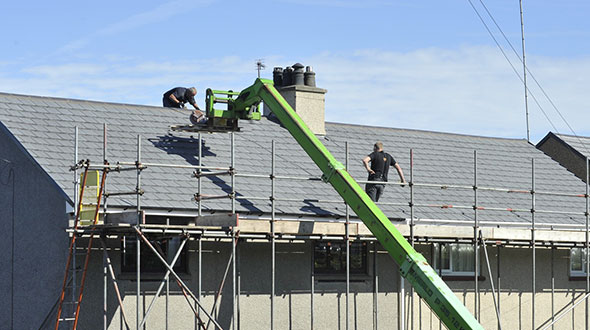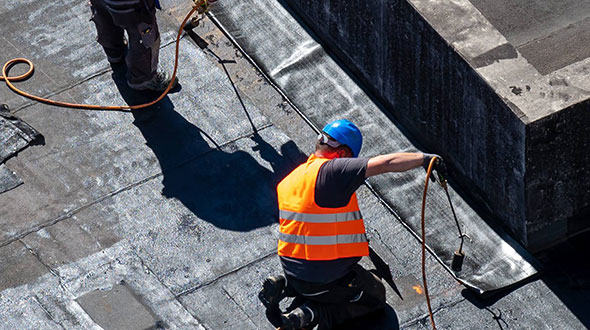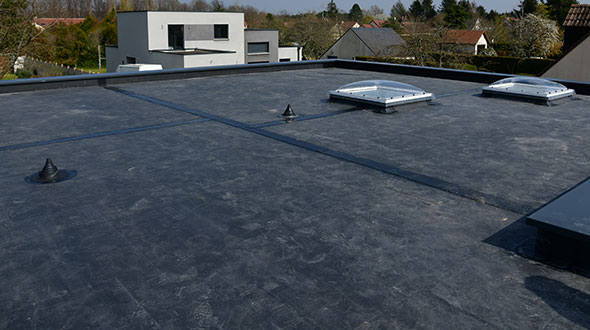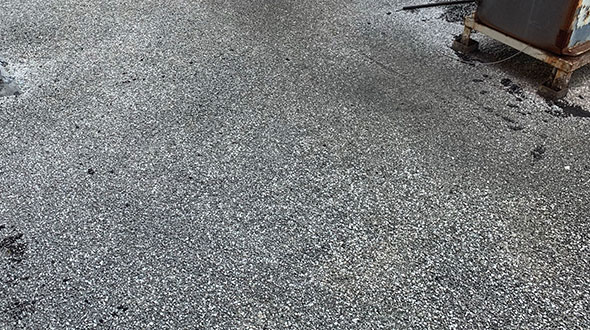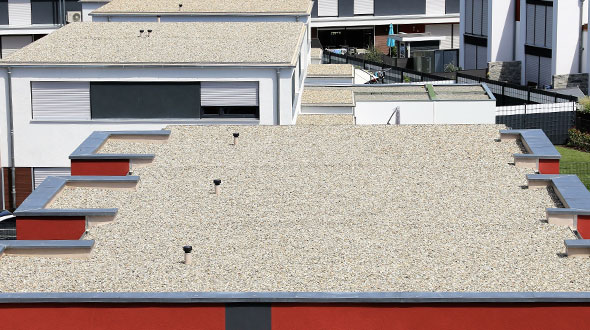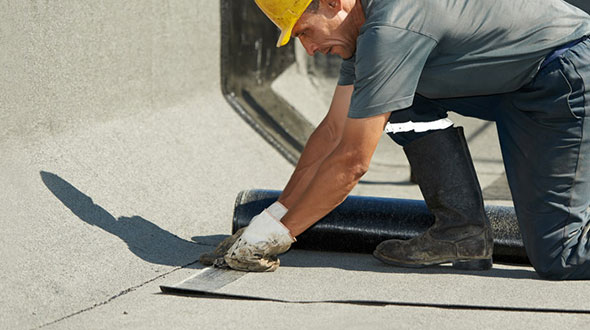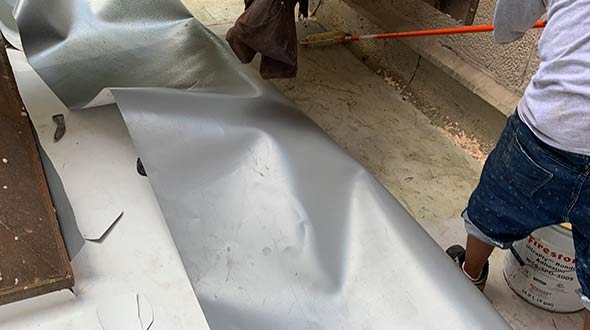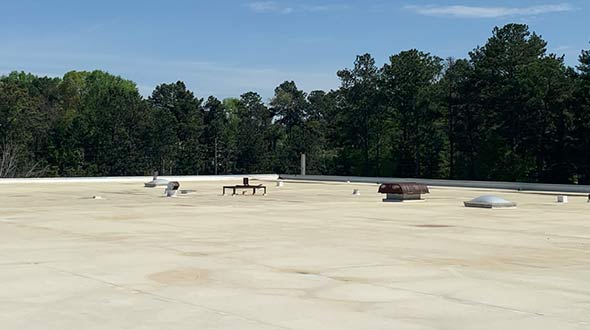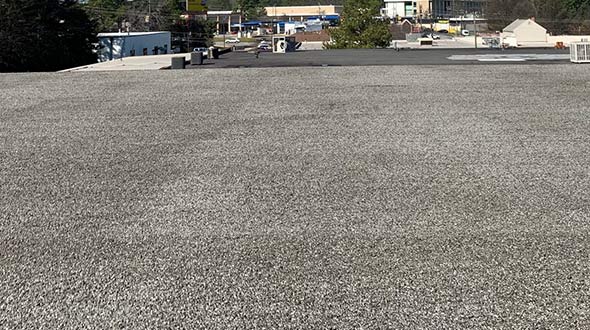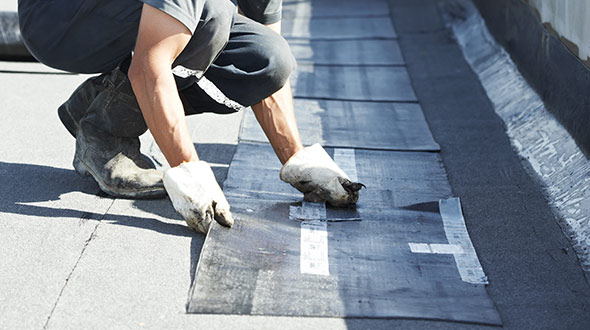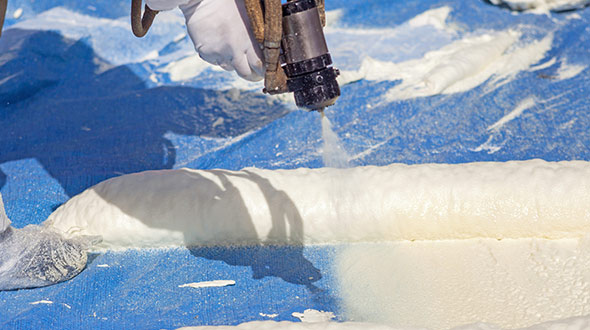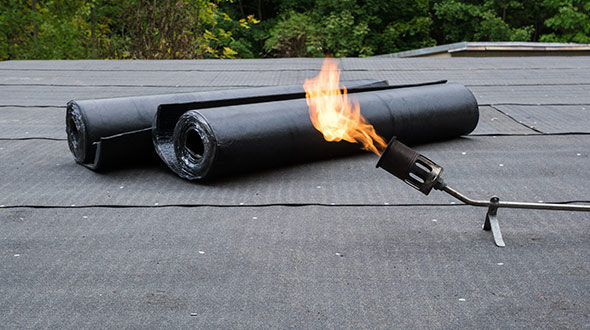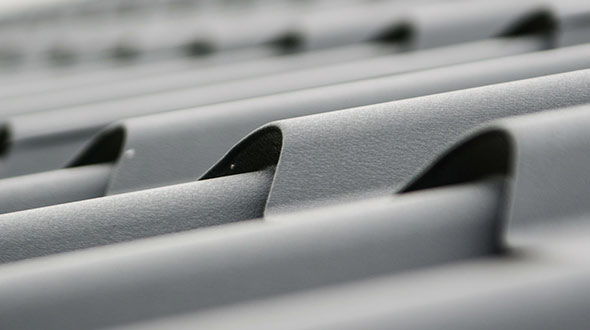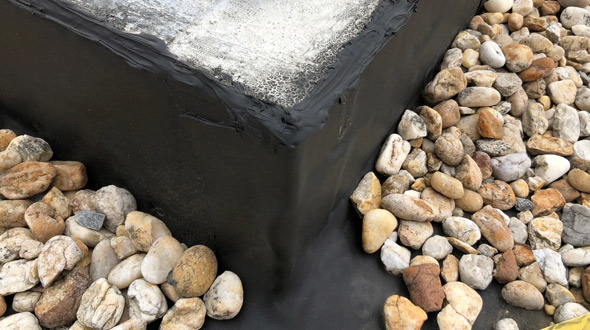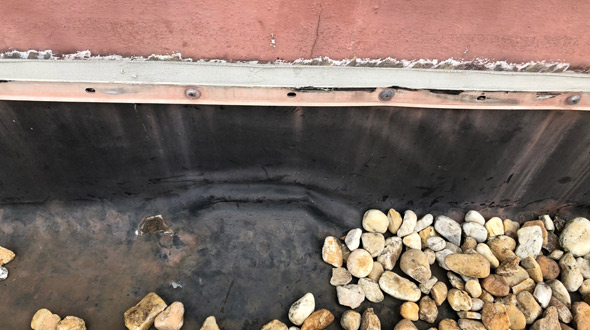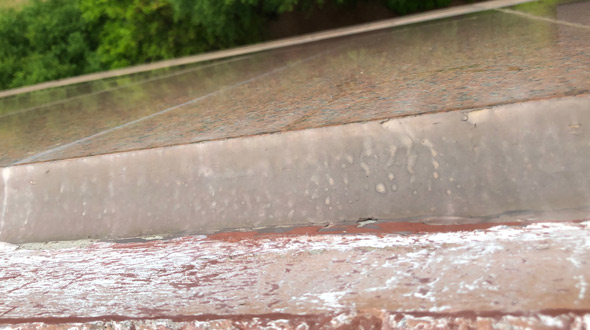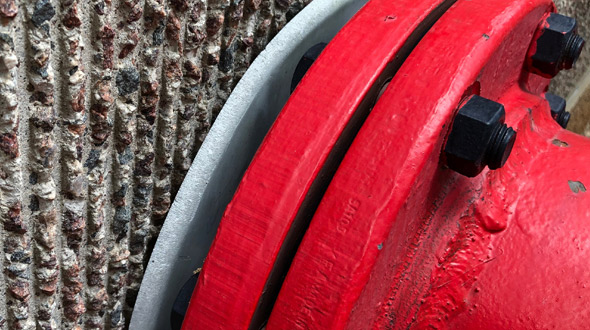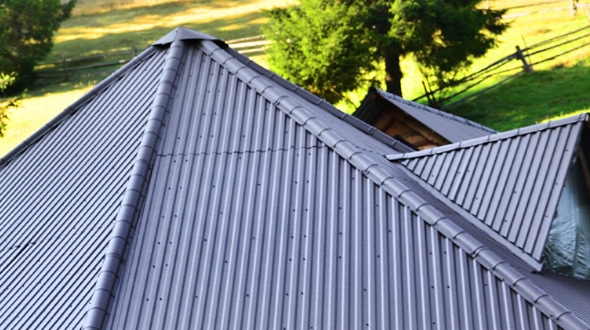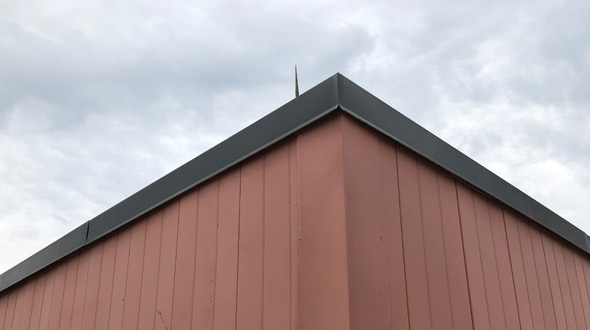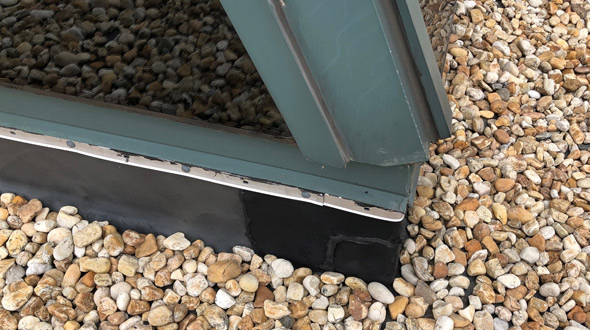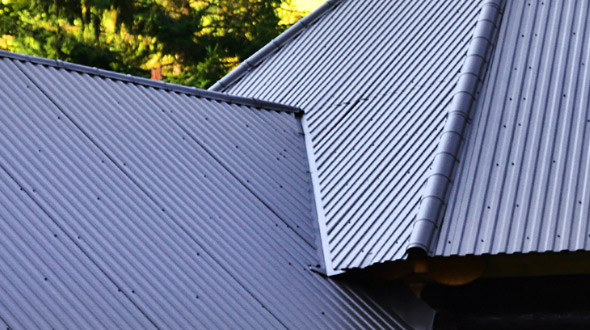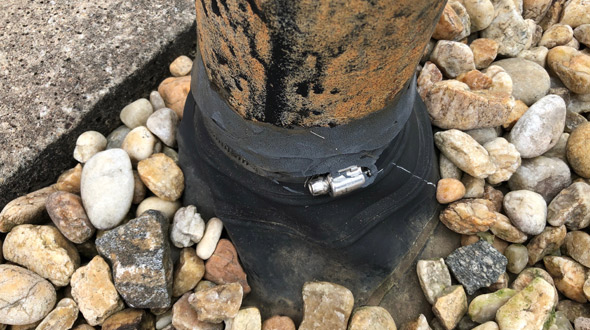
Are you considering a new flat roof for your home or commercial building? TPO (thermoplastic polyolefin) roofing systems are a popular choice in the industry. But what is it that sets TPO apart from other roofing materials? This article will explore TPO roofing from its composition to the installation process and compare it to other roofing materials. By the end, you’ll understand why TPO roofing is a top choice for flat-roof commercial buildings and whether it’s the right roofing system for your project.
Short Summary
- TPO roofing systems are a cost-effective and reliable option for commercial roofing and flat-roof properties, offering durability, heat reflection, and energy savings.
- Professional installation of a TPO roofing system is essential to its performance and longevity. Costs vary depending on material & labor factors but typically range from $6.00 to $14.00 per square foot for a complete TPO roof replacement.
- Ripped seams, punctured TPO, and pooling water lead to TPO repairs, but regular maintenance prevents a shortened lifespan.
- Before settling on a roofer to install or repair your TPO, ensure they have sufficient experience, licensing, references, and can provide a warranty.
Understanding TPO Roofing Systems

TPO roofing systems are a single-ply roofing membrane made with synthetic material and reinforcing scrim that provides a dependable and cost-effective roofing solution for commercial buildings and flat-roof properties.
Its UV resistance, heat-reflective properties, and flexibility make it popular among roofers, commercial contractors, and property owners.
TPO roofing is a relatively new addition to the roofing materials market, with about 33 years in existence. Still, it has already gained a reputation for its performance, especially on flat roofs.
Composition and Features
TPO is a single-ply three-layered membrane composed of a TPO polymer base, a polyester-reinforced scrim, and a TPO compounded top ply. Thermoplastic, in layman’s terms, means it becomes plastic when heated and hardens upon cooling.
TPO roofing offers superior stability and resistance to shrinking compared to EPDM, another popular thermoplastic membrane roofing material. An EPDM membrane can alligator, while TPO is less likely to shrink over time, resulting in a long-lasting, reliable system.
Furthermore, TPO roofing provides significant energy cost savings due to its highly reflective properties, which deflect the sun’s UV rays away from the building, keeping the interior cooler and reducing energy consumption.
Note: Geographic regions higher in altitude with high UV levels adversely affect the TPO and are often the number one problem TPO systems face in these regions.
Types of TPO Roofing Membranes and Their Thickness
TPO roofing membrane is typically sold in 45 mil, 60 mil, and 90 mil thicknesses, which is about the thickness of a heavy-duty trash bag. A thicker roof membrane should be considered for roofs that experience higher traffic (i.e., walkways or technicians routinely servicing rooftop units).
Two primary types of thermoplastic membrane roofing exist: Polyvinyl chloride (PVC) and thermoplastic polyolefin (TPO). TPO membranes have three layers, making them a highly durable and efficient choice for commercial buildings.
The TPO single-ply roofing membrane has gained popularity due to its energy advantages and durability. With its ability to resist heat and most UV rays, TPO roofing is an eco-friendly option that can yield significant energy savings for building owners.
TPO Roofing Installation Process
Following the specified installation process for TPO roofing is crucial to its performance and longevity. A high-level overview of installing TPO involves preparing the roof surface and substrate, choosing the proper insulation and thickness, attaching the membrane, and using a hot-air gun to weld the seams.
The heat-welded seams create a watertight seal that prevents leaks and protects your building’s interior. Hiring an experienced contractor to install TPO roofing is highly recommended due to the specialized tools and expertise required for a successful installation.
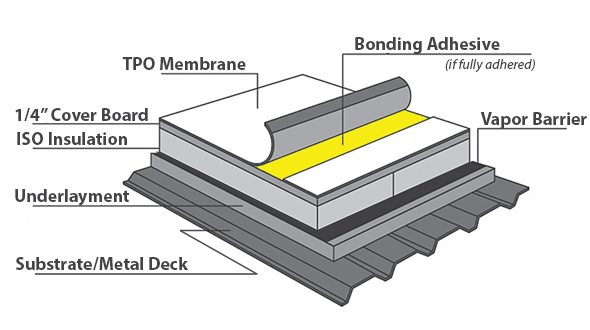
The layers of a complete, fully adhered TPO roofing system are as follows:
- TPO membrane
- Bonding adhesive (if fully adhered)
- Cover board (recommended on roofs with regular foot traffic)
- Insulation
- Vapor barrier (optional, but roofs over concrete decking should always have a vapor barrier)
- Underlayment (typically installed when an improved fire-resistive rating is required)
- Roof decking
Preparing the Roof Surface
Before installing a TPO roof, the existing substrate must be appropriately prepared to ensure a successful installation. This involves cleaning, repairing, and priming the substrate to create an even surface for optimal adhesion. A flat surface is essential during installation to ensure proper adhesion of the TPO membrane and prevent water damage.
Priming the substrate is a crucial step in the installation process. It involves applying a primer to the substrate, ensuring optimal adhesion. Once the surface is prepared, and the insulation foam is installed, the TPO membrane can be attached securely to the roof deck, providing a durable and energy-efficient roofing system.
Insulation and Mechanical vs Adhered Attachment Methods
Insulation sheet foam is the component that dictates energy efficiency and must be installed to guarantee a satisfactory level of heating and cooling efficiency within the property. Several insulation options are available for TPO roofing, such as foam board or batt insulation. The type of insulation selected depends on the existing roof type, necessary insulation levels, as well as the specific needs of your building.
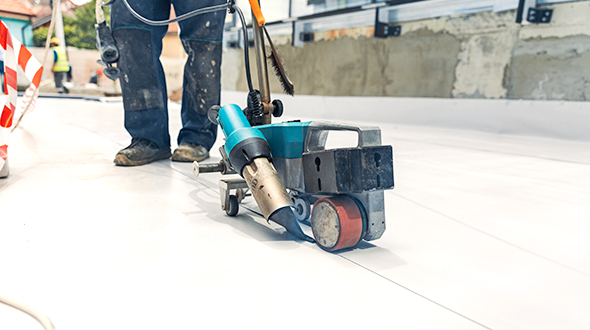
The TPO membrane can be mechanically attached using fasteners or attached using a fully adhered adhesive system. In mechanically fastened systems, the membrane is attached in the seams using fasteners and plates or battens. Fully adhered systems are completely bonded to the substrate beneath, creating a tighter and more secure looking TPO membrane. The bonding adhesives can’t be applied below certain temperatures. However, the adhesive in fully adhered systems evenly distributes the uplift pressure on the membrane and substrate, rather than focusing it on fastening points in the seams as the mechanically attached method does. This is why fully adhered systems typically have superior wind uplift results. Conversely, mechanically attached systems are often more cost-effective and have fewer installation restrictions. Each method offers advantages and is chosen based on factors such as the building’s structure, climate, and budget.
Regardless of the attachment method used, proper installation is crucial to ensure the longevity and performance of your TPO roofing system.
Comparing TPO Roofing to Other Roofing Materials
While TPO roofing is more expensive than some roofing materials, it offers several advantages that make it a popular choice for commercial buildings. Its highly reflective surface helps reduce energy costs by deflecting the sun’s UV rays away from the building. TPO is more energy efficient and durable than other materials like EPDM roofing.

However, TPO roofing also has some disadvantages compared to other materials. For instance, its lifespan is typically shorter than some roofing materials, lasting up to 25 years when installed correctly. Additionally, its quality may not be as certain as other roofing types since it is still a relatively new material.
Advantages of TPO Roofing
One of the main advantages of TPO roofing is its energy efficiency. The reflective properties of the TPO membrane help lower energy expenses by deflecting the sun’s UV rays away from the building, keeping the interior cooler, and reducing the need for air conditioning.
Secondly, TPO roofing is known for its resistance to mold and some puncturing, contributing to its durability and long-lasting performance.
Another advantage of TPO roofing is its eco-friendliness. Since it is a single-ply roofing membrane, it requires fewer manufacturing materials, resulting in less waste during production. Moreover, TPO material is recyclable, making it a more sustainable choice than other roofing materials that may end up in landfills.
Disadvantages of TPO Roofing
Despite its many advantages, TPO roofing does have some drawbacks. As mentioned earlier, the lifespan of TPO roofing is shorter when not well maintained compared to other materials like metal. TPO typically lasts from 15-25 years when installed correctly.
Additionally, TPO roofing membranes typically come in small-width rolls, resulting in seams every six to eight feet. These membranes experience contractions and expansions, and the seams are often where the membranes become loose, enabling water leaks.
In addition to more seams, TPO roofing membranes can have varying qualities depending on the manufacturer. Some manufacturers produce superior products, while others may construct lower-quality membranes. It is essential not to get swayed by price only but to choose a manufacturer with a long history and better reputation.
Lastly, TPO systems installed in high-altitude regions with high UV ray levels encounter a significant problem; as these conditions age the TPO quicker. Also, UV ray overexposure degrades the adhesives that attach the membrane and insulation to the substrate, causing the seams to separate and lose the watertight seal.
TPO Roofing Costs and Factors Affecting Pricing

TPO roofing costs can be broken down into two main components: materials and labor. An all-inclusive removal and installation of a TPO roofing system typically range from $6 to $14 per square foot, making it a competitive option. This includes material costs of $1.50 to $4.50 per square foot, labor costs of $3.50 to $7.50 per square foot, and the remaining $1.00 to $2.00 per square foot cost covers the removal and disposal of the current roofing material.
Several factors can affect your roof replacement and pricing of TPO, including hourly contractor charges, roof removal costs, climate, and accessibility. A roofing cost calculator is helpful, and it is essential to consider these factors when estimating the overall cost of your TPO roofing project, as they can significantly impact the final price.
Material Costs
The material costs associated with TPO roofing range from $1.50 to $4.50 per square foot for the TPO membrane system, while insulation costs vary. Commodity prices and supply chain dynamics impact TPO roofing material prices, so the timing of your project is a consideration and factor in your material cost.
Flashing is another essential component of TPO roofing, as it helps prevent leaks around seams and penetrations such as pipes, drains, chimneys, and skylights. The cost of flashing will depend on the specific requirements of your building and the complexity of the installation, so it’s essential to factor this in when estimating your overall TPO roofing costs.
Labor Costs and Installation Factors
Labor costs for TPO roofing typically range from $3.50 to $7.50 per square foot, depending on factors such as hourly contractor charge, climate, and accessibility. Considering these factors when estimating the overall TPO roofing cost is essential, as they can significantly impact the final price.
Roof removal cost is the third factor impacting your roof replacement and TPO installation. Typically $1.00 to $2.00 per square foot covers the removal and disposal of the current roofing system. Sometimes, this cost is just factored into labor and not itemized out separately.
However, when hiring a TPO roofing contractor, it’s crucial to obtain multiple quotes and compare labor costs and installation factors each contractor provides. This will ensure that you get the best value for your investment and select a contractor who can provide a high-quality installation at a competitive price.
Maintaining and Repairing Your TPO Roof
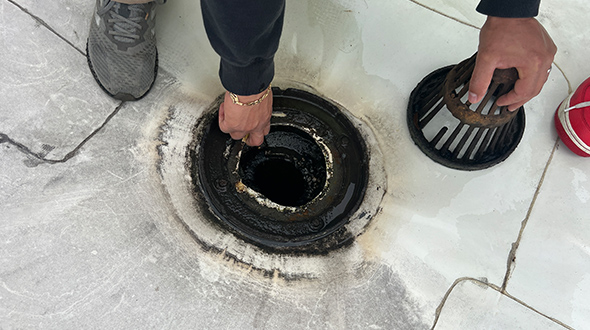
The first step in maintaining and repairing your TPO roof system is a regular and proactive inspection program. Your TPO needs regular maintenance and repairs to prevent water damage, preserve its integrity, and ensure a long-lasting roofing system. Maintaining your TPO roof includes cleaning debris, washing it with a light detergent, and inspecting it for damage to the membrane.
Commercial roofing companies offer maintenance plans to accommodate these needs. It is recommended to enlist the services of a professional roofer, as the maintenance professional will have the expertise and tools necessary to identify and address all issues necessary to preserve your TPO roofing system.
Regular Maintenance Tips
To maintain your TPO system, you must identify issues before they become significant problems that require costly repairs. Thus part of the technician’s routine is to regularly inspect for cracks, tears, or punctures in the membrane.
Additionally, removing debris and washing your TPO roof with a low-power pressure washer, gentle cleaner, and a soft-bristle broom is advised. This will help keep your TPO roofing system clean and free from dirt, which can cause damage over a prolonged period.
Furthermore, ensuring proper drainage will help prevent water from pooling on the surface and causing damage to your TPO membrane. Dysfunctional scuppers and clogged gutters will prevent water from escaping and cause pools of water on your TPO.
Note: Do not overlook routine maintenance, as a punctured or dirty TPO, compromised seams, degrading adhesion, or a TPO membrane with continual standing water will certainly have a shorter lifespan.

Common Repair Issues and Solutions
Common repair issues for TPO roofs include degrading seams, failed flashings, or a punctured membrane. A TPO patch is a common fix for areas that have been punctured or cracked. In some cases, small hot air welders can be used to make minor repairs to the seams of your TPO roofing.
Flashing on parapet walls and roof edges often needs re-flashing. Likewise, mechanical fastener issues and malfunctioning roof drains and scuppers call for repairs and immediate attention.
When TPO shows signs of severe deterioration or cannot be patched on its top surface, underside patch placement, and reverse-side welding can temporarily prolong its lifespan. However, eventually, a new roof will be necessary.
If you notice water entering your building or suspect your TPO system is damaged, contacting a professional roofer is essential. They can assess the situation, identify the problem, and recommend the best course of action to repair your TPO roof and protect your property from further damage.
Hiring a Professional TPO Roofing Contractor
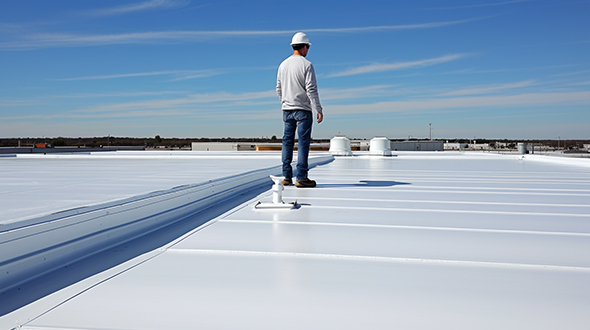
Due to the specialized tools and expertise required for TPO roofing installation, hiring a professional TPO roofing contractor is highly recommended. They will ensure that your TPO roofing system is installed correctly and provides the desired performance and longevity for your commercial building.
When selecting a TPO roofing contractor, evaluating their experience, certifications, references, and warranties is essential. This will help you choose a reliable and qualified contractor for your roofing project and ensure that your TPO roofing system is installed correctly and efficiently.
Evaluating Contractors
To evaluate TPO roofing contractors, obtaining multiple quotes and comparing their expertise, certifications, references, and warranties is critical. This will help you select a reliable and qualified contractor for your roofing project and ensure that your TPO roofing system is installed correctly and efficiently.
Additionally, researching online customer reviews and ratings can provide valuable insight into the contractor’s reputation and the quality of their work. By evaluating potential TPO roofing contractors, including checking their membership with the National Roofing Contractors Association, you can feel confident in your decision and trust that your TPO roofing system will be installed to the highest standards.
Questions to Ask Before Hiring

Before hiring a TPO roofing contractor, you should ask several questions to ensure you select the best person for the job. These questions may include their experience with TPO roofing, certifications, pricing, warranties, and safety precautions.
By asking these questions and carefully considering the responses, you can make an informed decision about which TPO roofing contractor is the best fit for your project. This will help ensure that your TPO roofing system is installed correctly, providing you with a durable, energy-efficient, and long-lasting roofing solution for your commercial building.
Summary
In conclusion, TPO roofing systems offer a durable, energy-efficient, and eco-friendly solution for commercial buildings. Its unique composition and installation process makes it popular among building owners and roofing contractors. While TPO roofing may be more expensive than other roofing materials, its advantages, such as energy efficiency, durability, and recyclability, make it a worthwhile investment.
By performing regular maintenance and repairs, hiring a professional TPO roofing contractor, and carefully evaluating your options, you can ensure that your TPO roofing system provides the desired performance and longevity for your commercial building. So, if you’re considering a new roof for your property, TPO roofing may be the ideal choice to meet your needs and support your commitment to sustainability.
Frequently Asked Questions
What is TPO roofing?
TPO (Thermoplastic Polyolefin) roofing is a single-ply membrane composed of 3 layers: a TPO polymer base, a polyester-reinforced scrim, and a TPO compounded top ply. It was introduced in the early 90s and is used to create a watertight covering to protect the interior of a building.
TPO provides durable and cost-effective protection from the elements for many types of buildings.
How long does a TPO roof last?
A TPO roof can last up to 20 years with proper maintenance. TPO roofing material is thermoplastic polyolefin – a blend of ethylene propylene rubber and polypropylene components fused and reinforced with polyester fabric.
Well-cared-for TPO roofs can provide many years of protection from the elements.
Which is better, TPO or EPDM roofing?
When choosing the best roofing material for your project, deciding between TPO and EPDM can be difficult. Both offer significant advantages, so it’s essential to consider their respective features and the needs of your particular project to determine the better option for you.
TPO is a thermoplastic membrane that is highly resistant to UV radiation, making it an excellent choice for areas with high levels of sunlight. It is also highly resistant to punctures and tears, making it a great choice.
Why is TPO traditionally used for roofing?
TPO roofing material is a single-ply membrane designed to protect your commercial building from the elements. It’s traditionally used for roofing because of its durability and strength, making it ideal for harsh weather conditions. Its reflective surface also helps with energy efficiency.
What is TPO roofing?
TPO roofing is a durable single-ply membrane system consisting of three layers – a TPO polymer base, a polyester-reinforced scrim, and a TPO compounded top ply – introduced in the early 90s. It provides a reliable, watertight covering that can stand up to the elements and help protect the interior of a building.
TPO roofing is an excellent choice for many commercial and flat-roof residential buildings, as it is highly resistant to moderate UV radiation and extreme temperatures. It is also easy to install and maintain, making it a cost-effective solution for many roofing needs.
